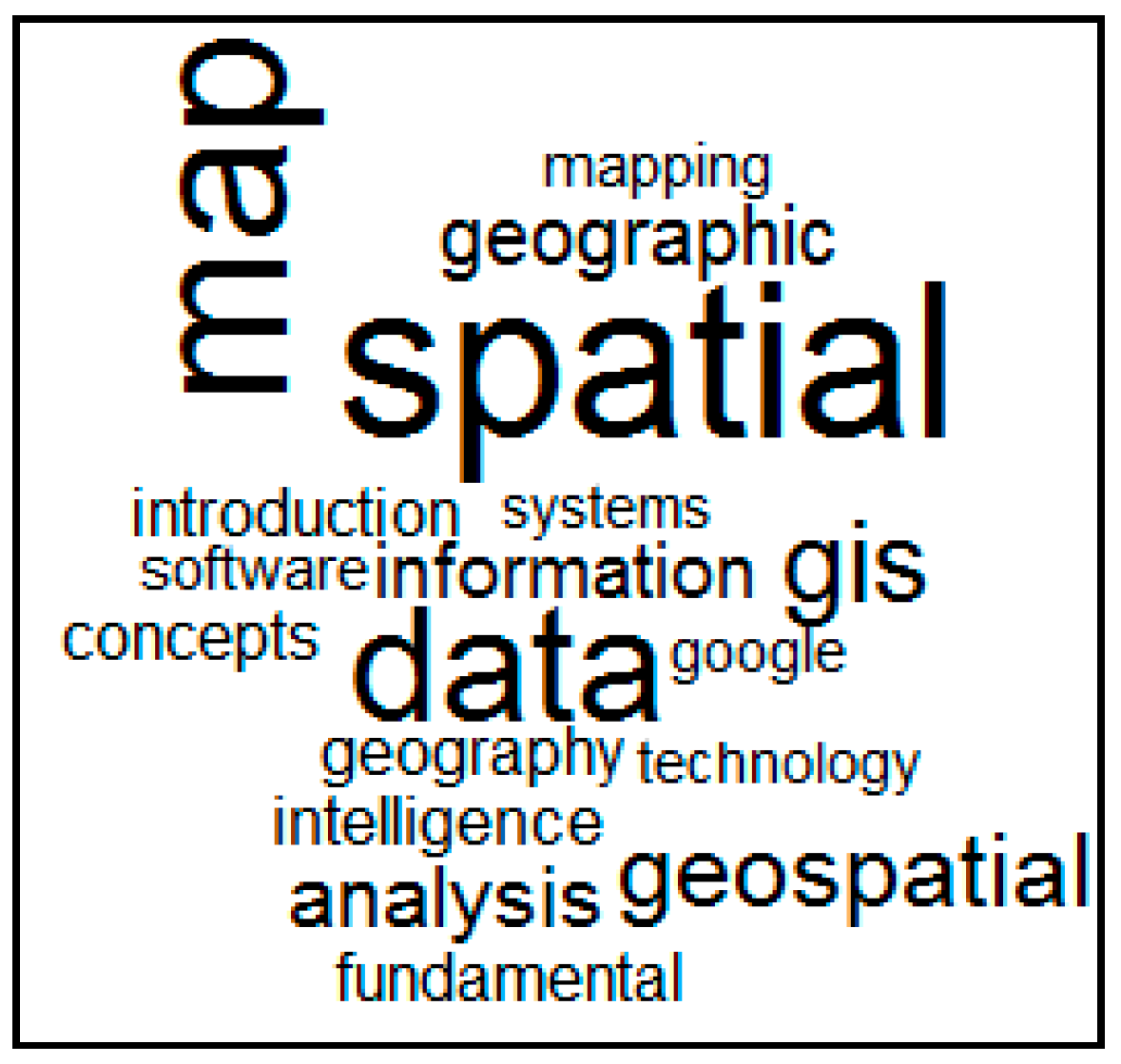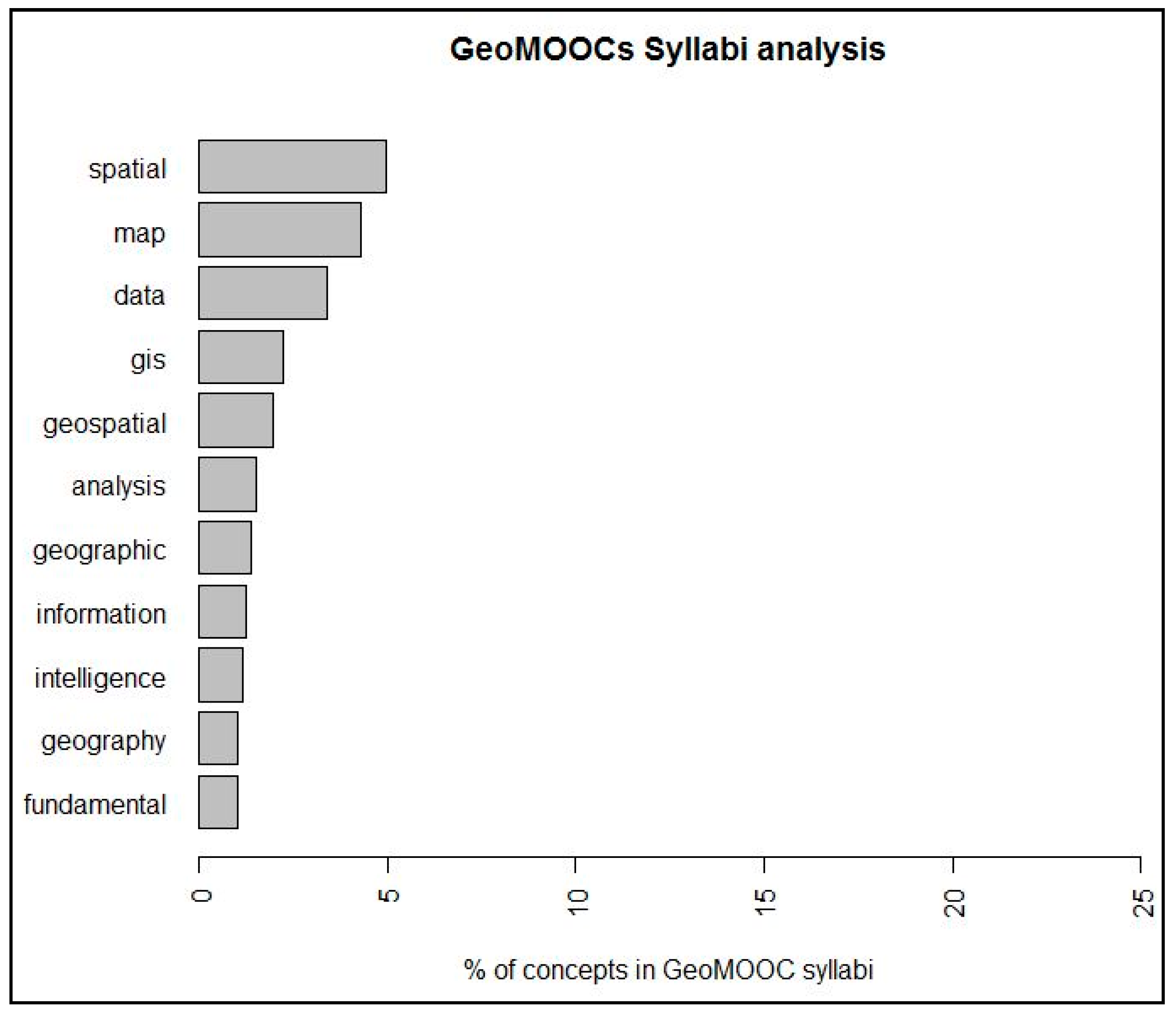Open Geospatial Education
Abstract
:1. Introduction
2. Online (Open) Education Resources
2.1. Massive Open Online Courses (MOOCs)
| Traditional (on-Campus) Classes | MOOCS | |
|---|---|---|
| Registration date | Fixed registration period | Flexible/open registration in case of self-paced MOOCs; or registration date, class launch date and completion date in case of scheduled-based MOOCs |
| Formal educational pre-requisites | Yes | No |
| Geographic coverage | Geographically more homogeneous | Wide/global reach |
| Course participation | Class attendance/synchronous | Online attendance/asynchronous or synchronous |
| Curriculum | Directed learning: Sequential class topics starting with introductory topics, followed by specialized topics | Non-directed learning: MOOCs dedicated to introductory topics or a series of courses packed together lead to specialization certificate |
| Scheduling | Pre-defined course outline and syllabus | Flexible, especially in self-paced MOOCs |
| Evaluation | Final course grade and credit | (Verified) Certificate of completion |
| Instructor-student interaction | One-on-one or one-to-many engagement | Group/community engagement |
| Communication among enrolled students | Individual learning | Social learning/online learners interaction |
| Content delivery | Diverse content delivery mechanism | See cMOOCs vs. xMOOCs |
| Costs | (Usually) tuition fee | No costs incurred/no penalty for leaving |
- •
- Registration date: MOOCs are flexible in terms of registration date, except for scheduled MOOCs. The registration flexibility increases the overall diversity of course participants because “as long as enrolments are unrestricted, with no selection mechanism based on commitment or intent, MOOC participants will vary in preparation and goals far more than in traditional residential courses” [17].
- •
- Formal educational pre-requisites: Learners with different backgrounds, trainings and age can participate in MOOCs. The lack of formal educational pre-requisites limiting course access leads to an increasing diversity of learners [18].
- •
- Course participation: MOOCs are not entirely synchronous since the participants attend the course according to their own schedules [10].
- •
- Curriculum: MOOCs do not follow an academic curriculum leading to a degree award. Recently, a series of open courses have been organized into modules that lead to participants’ specialization within a specific domain.
- •
- Scheduling: MOOCs are sometimes not strictly operationalized by course outline.
- •
- Evaluation: Students’ achievements are assessed through weekly quizzes, periodic assignments and/or final projects. The scalability of the assessment methods need to be adjusted in these global classrooms [5], where the number of participants varies from hundreds to thousands of learners and beyond. Multiple-choice quizzes that can be automatically graded, participation in class discussions (evaluated through the number of discussion threads) [5] and peer assessment tasks are proposed as suitable solutions to assess the achievements of MOOCs participants [10].
- •
- Instructor-student interaction: Given the large number of enrolled MOOC participants, individual instructor-student interaction can be hardly achieved. Therefore, participants are encouraged to interact with their peers and to join online co-learner communities.
- •
- Communication among enrolled students: Online discussion forums, comprising sub-forums for technical feedback, introduction of study groups, readings groups, lecture discussions, final project forums [10,19] or an open Ask me Anything [5] forum section, are important components of MOOCs. Seaton et al. [14] have proven that a large number of enrolled students spend more time on posting or reading discussion threads than on watching featured videos or reading additional learning materials. Analysis of digital traces of online learners reveals that forum participation levels drop significantly towards the end of the course [19]. Therefore, mechanisms for stimulating online forum discussions need to be put into place in order to make online communities effectives and sustainable [19]. Some courses require participants to engage in discussions with other course participants and to be active on threaded discussion lists in order to achieve a certificate of completion. This kind of incentive is motivating participants to interact with their peer learners.
- •
- Content delivery: As mentioned above, content development and delivery options vary between xMOOCs and cMOOCs categories.
- •
- Costs: Most current MOOCs are offered for free.
2.2. GeoMOOCs: What is Special about Open Geospatial Education?
| Nr. | Name of the Course | Learning Management Platforms/University | Certificates | Costs | Course Model |
|---|---|---|---|---|---|
| 1 | Maps and the Geospatial Revolution | Coursera/Penn State University | Verified Certificate of completion | free (cost for verified certificate) | Scheduled |
| 2 | Geospatial Intelligence & the Geospatial Revolution | Coursera/PennState University | Verified Certificate of completion or Statement of Accomplishment | free (verified certificates costs) | Scheduled |
| 3 | Going Places with Spatial Analysis | Udemy/ESRI | Certificate of completion | free | Scheduled |
| 4 | From GPS and Google Maps to Spatial Computing | Coursera/University of Minnesota | Certificate of completion; students completing more advanced track (called technical track) receive a distinguished statement of accomplishment | free | Scheduled |
| 5 | Skills for the Digital Earth (D2L) | Desire2learn/Elmhurst College | Certificate of completion * | free | Scheduled |
| 6 | Geospatial Tech for STEMx Learning | Canvas/Del Mar College | Certificate of completion | free | Self-paced |
| 7 | Introduction to Geospatial technology using QGIS | Canvas/Del Mar Col lege | Opportunity to obtain education credit from a regionally accredited college | free | Scheduled |
| 8 | Mapping with Google | Certificate of completion | free | Self-paced | |
| 9 | Basic GIS with gvSIG | gvSIG Association | Certificate of completion | Free or a small fee for gvSIG user certification program | Self-paced |
| 10 | GIS on the Web | Lynda.com | Certificate of completion | Platform membership fee | Self-paced |
| 11 | Sharpen your GIS Skills | Udemy/Esri experts | Certificate of completion | free | Self-paced |


3. Synergies between Open Geospatial Education, Cyberinfrastructure, Free and Open Source Software (FOSS) and Open Data

4. Discussion
5. Conclusions
Author Contributions
Conflicts of Interest
References
- Goodchild, M.F. The Fourth R? Rethinking GIS Education. Available online: http://www.esri.com/news/arcnews/fall06articles/the-fourth-r.html (accessed on 30 January 2015).
- Riihelä, J.; Mäki, S. Designing and implementing an online GIS tool for schools: The Finnish case of the PaikkaOppi Project. J. Geogr. 2014, 114, 15–25. [Google Scholar] [CrossRef]
- Strobl, J. Time to Open Up. Available online: http://geospatialworld.net/uploads/magazine/January-2015-Geospatial-World-Magazine/index.html (accessed on 22 April 2015).
- Dong, S.; Xu, S.; Lu, X. Development of online instructional resources for Earth system science education: An example of current practice from China. Comput. Geosci. 2009, 35, 1271–1279. [Google Scholar] [CrossRef]
- Robinson, A.C.; Kerski, J.; Long, E.C.; Luo, H.; DiBiase, D.; Lee, A. Maps and the geospatial revolution: Teaching a massive open online course (MOOC) in geography. J. Geogr. High. Educ. 2015, 39, 65–82. [Google Scholar] [CrossRef]
- OECD Giving Knowledge for Free: The Emergence of Open Educational Resources. Available online: http://www.oecd.org/edu/ceri/38654317.pdf (accessed on 1 April 2015).
- Sui, D. Opportunities and impediments for open GIS. Trans. GIS 2014, 18, 1–24. [Google Scholar] [CrossRef]
- McAndrew, P. Defining openness: Updating the concept of “open” for a connected world. J. Interact. Media Educ. 2010. doi:http://dx.doi.org/10.5334/2010-10. [Google Scholar]
- Livingstone, D.W. Adults’ Informal Learning: Definitions, Findings, Gaps and Future Research; Centre for the Study of Education and Work, OISE/UT: Toronto, ON, Canada, 2001. [Google Scholar]
- Hew, K.F.; Cheung, W.S. Students’ and instructors’ use of massive open online courses (MOOCs): Motivations and challenges. Educ. Res. Rev. 2014, 12, 45–58. [Google Scholar] [CrossRef]
- DeBoer, J.; Ho, A.; Stump, G.S.; Pritchard, D.E.; Seaton, D.; Breslow, L. Bringing student backgrounds online: MOOC user demographics, site usage, and online learning. In Proceedings of the 6th International Conference on Educational Data Mining, Memphis, TN, USA, 6–9 July 2013.
- ArcNews ESRI to Offer Spatial Analysis MOOC. Available online: http://www.esri.com/esri-news/arcnews/summer14articles/esri-to-offer-spatial-analysis-mooc (accessed on 24 January 2015).
- Hofer, B.; Wallentin, G.; Traun, C.; Strobl, J. Workforce demand assessment to shape future GI-Education—First results of a survey. In Proceedings of the 17th AGILE Conference on Geographic Information Science, Castellón, Spain, 3–6 June 2014.
- Seaton, D.; Chuang, I.; Mitros, P.; Pritchard, D. Who does what in a massive open online course? Educ. XPress 2013, 2013, 1–1. [Google Scholar]
- Conole, G. MOOCs as disruptive technologies: Strategies for enhancing the learner experience and quality of MOOCs. Rev. Educación Distancia 2013, 39, 1–17. [Google Scholar]
- Clark, D. MOOCs: Taxonomy of 8 types of MOOC. Donald Clark Plan B Blog. Publ. 2013, 16, 4–13. [Google Scholar]
- DeBoer, J.; Ho, A.D.; Stump, G.S.; Breslow, L. Changing “course” reconceptualizing educational variables for massive open online courses. Educ. Res. 2014. [Google Scholar] [CrossRef]
- Ellul, C. Can free (and open source) software and data be used to underpin a self-paced tutorial on spatial databases? Trans. GIS 2012, 16, 435–454. [Google Scholar] [CrossRef]
- Gillani, N.; Eynon, R. Communication patterns in massively open online courses. Internet High. Educ. 2014, 23, 18–26. [Google Scholar] [CrossRef]
- R-Development-Core-Team. R: A Language and Environment for Statistical Computing; R Foundation for Statistical Computing: Vienna, Austria, 2013. [Google Scholar]
- Li, N.; Raskin, R.; Goodchild, M.; Janowicz, K. An ontology-driven framework and web portal for spatial decision support. Trans. GIS 2012, 16, 313–329. [Google Scholar] [CrossRef]
- Yang, C.; Raskin, R.; Goodchild, M.; Gahegan, M. Geospatial cyberinfrastructure: Past, present and future. Comput. Environ. Urban Syst. 2010, 34, 264–277. [Google Scholar] [CrossRef]
- Craglia, M.; Annoni, A. INSPIRE: An innovative approach to the development of spatial data infrastructures in Europe. In Research and Theory in Advancing Spatial Data Infrastructure Concepts; Onsrud, H., Ed.; ESRI Press: Redlands, CA, USA, 2007; pp. 93–105. [Google Scholar]
- Yang, C.; Xu, Y.; Nebert, D. Redefining the possibility of digital Earth and geosciences with spatial cloud computing. Int. J. Digit. Earth 2013, 6, 297–312. [Google Scholar] [CrossRef]
- Hofer, B. Uses of online geoprocessing technology in analyses and case studies: A systematic analysis of literature. Int. J. Digit. Earth 2014. [Google Scholar] [CrossRef]
- Goodchild, M.F.; Li, L. Assuring the quality of volunteered geographic information. Spat. Stat. 2012, 1, 110–120. [Google Scholar] [CrossRef]
- Haklay, M. How good is volunteered geographical information? A comparative study of OpenStreetMap and Ordnance Survey datasets. Environ. Plan. B Plan. Des. 2010, 37, 682–703. [Google Scholar] [CrossRef]
- Heipke, C. Crowdsourcing geospatial data. ISPRS J. Photogramm. Remote Sens. 2010, 65, 550–557. [Google Scholar] [CrossRef]
- Teodoro, A.C.; Duarte, L. Forest fire risk maps: A GIS open source application—A case study in Norwest of Portugal. Int. J. Geogr. Inf. Sci. 2012, 27, 699–720. [Google Scholar] [CrossRef]
- DiBiase, D.; DeMers, M.; Johnson, A.; Kemp, K.; Luck, A.T.; Plewe, B.; Wentz, E. Introducing the first edition of geographic information science and technology body of knowledge. Cartogr. Geogr. Inf. Sci. 2007, 34, 113–120. [Google Scholar] [CrossRef]
- DiBiase, D.; Corbin, T.; Fox, T.; Francica, J.; Green, K.; Jackson, J.; Jeffress, G.; Jones, B.; Jones, B.; Mennis, J. The new geospatial technology competency model: Bringing workforce needs into focus. URISA J. 2010, 22, 55–72. [Google Scholar]
© 2015 by the authors; licensee MDPI, Basel, Switzerland. This article is an open access article distributed under the terms and conditions of the Creative Commons Attribution license (http://creativecommons.org/licenses/by/4.0/).
Share and Cite
Belgiu, M.; Strobl, J.; Wallentin, G. Open Geospatial Education. ISPRS Int. J. Geo-Inf. 2015, 4, 697-710. https://doi.org/10.3390/ijgi4020697
Belgiu M, Strobl J, Wallentin G. Open Geospatial Education. ISPRS International Journal of Geo-Information. 2015; 4(2):697-710. https://doi.org/10.3390/ijgi4020697
Chicago/Turabian StyleBelgiu, Mariana, Josef Strobl, and Gudrun Wallentin. 2015. "Open Geospatial Education" ISPRS International Journal of Geo-Information 4, no. 2: 697-710. https://doi.org/10.3390/ijgi4020697
APA StyleBelgiu, M., Strobl, J., & Wallentin, G. (2015). Open Geospatial Education. ISPRS International Journal of Geo-Information, 4(2), 697-710. https://doi.org/10.3390/ijgi4020697








